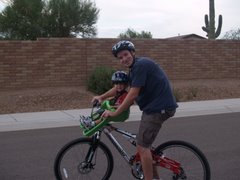Well for those of you that don't know, I have finally decided to go to school. The decision was not an easy one to come by and I am sure there will be definate questions along the way. I am excited for this new journey in my life, and know in my heart you can't go wrong with obtaining a degree.
With that said, here is the final analysis paper that was due in my first writing class. Just so you know the story is about snowboarding and happens to be ten pages long. I hope you enjoy.
Snowboarding: An Extreme Sport for Today
I fell in love with the sport of snowboarding ten years ago. I was drawn to the sport due to my enjoyment of surfing and skateboarding. Snowboarding to me looked similar to both, and I felt compelled to learning and excelling at something new. My determination was steadfast and as a result, I am a snowboard instructor in the southernmost ski resort in the U.S. By writing about snowboarding, I hope to motivate others to take up the greatest winter sport of all time.
I approached the majestic snow-covered mountains. There were plummeting drops, narrow paths, and rocks, yet as I moved closer, the great mountain continued to rise and demanded all to take notice. Summoning me was a towering wonderland of different variations of endless fun. In my amazement I saw smooth groomed snow, powder, moguls, and turkey trails. I knew I could only be held back by my inhibitions. I also gazed upon a dense forest mixed of cedar, pine, oak, and aspen anxiously awaiting my arrival perfectly aligned as if to greet me. Beneath the trees I saw powder invaded by a single track, interrupted in its slumber. There were wide open spaces inhabited by thrill seekers of every skill level. I couldn’t wait, all I could think about was finding the lodge and getting my equipment rented.
Not knowing what to expect behind the rental table, I saw the snowboard waiting to be taken into the wild. I was on a mission to attain it as quickly as possible. The snowboard of choice was a K2 FatBob which happens to be designed for riders with larger feet. The board’s base colors were a faded forest green with yellow undertones. There was also a swooshing serpent-like figure interwoven into the design in what once was a brilliant white. Silver also lined the edge of the board all the way around, but this was different. I was not seeing a paint color but rather a metal used to control and give stopping power to the occupant of this K2 death bringer. My eyes were drawn to multiple scratches but none of them stood out like the small chunk of melted chocolate almost directly centered in the middle of the board. There also looked to be caramel and nuts there. I wondered, how that could have been overlooked but then instantly dismissed the attitude so as to not jeopardize my success on the slopes. I took a deep breath, possibly out of disgust but as I did a faint aroma passed through my flared nostrils. Chocolate indeed and I thought, “Had to be a Snickers bar.” My mouth started to water and I could almost taste that crunchy sweet goodness. I had been equipped with a Snickers bar and was no stranger to its ingredients. Another small detail that caught my eye was the binding. There were two circles, one for the left foot and the other for the right, spaced a shoulder length apart. What struck me as awkward is there were no straps, nothing that braced my foot securely onto this God-forsaken sled of death. Certain there had been a mistake, I objected, but before I could finish I was informed that there was no mistake. I had been given step-in bindings that connected with a hook that snapped in toe to heel. I was perplexed and curious but left it alone. My bottled-up excitement was like a shaken two-liter bottle of soda. I could not take it any longer.
The slopes were sunny on that great day in late December. The sun’s reflection off the glistening ice pierced through my sunglasses, and I found momentary relief in the shadows of nearby trees. The temperature, a mere 57 degrees, was brisk. Yet, beneath my layer upon layer of clothing I was perspiring profusely. In my over-preparation for cold weather I was extremely weighted down. My first-time boarding skills left me working harder than necessary for a result that was less than spectacular. I needed to get down the mountain and shed the unnecessary clothing. Proceeding as if on a mission, under my breath I uttered, “Don’t look like a rookie, speed it up.” I was doing well and holding my own in difficult circumstances. The motion of the simple falling-leaf maneuver had come and gone and I was successfully linking turns. I was transitioning well from heel edge to toe edge and building speed fast.
My attitude was that of, “I got this; I am a natural!” My confidence grew. I began to feel my concentration go from what I was doing to how I looked on the slopes. Periodically I glanced at a good looking snow-bunny in the distance while kids no older than seven or eight passed me with reckless abandon. I needed and wanted to go faster, and appear that I too had years of experience. That was the moment of regret. Suddenly I had been launched as if I were Evel Knievel on the jump of my life! I had caught my toe edge and was doing an all out superman. My thoughts raced and I knew this was going to hurt. I hit the snow hard, beanie and sunglasses ripped off as my forehead pounded against the great mountain, yet the worst was still to come. My legs swung up in the air, and the snowboard cracked the back of my head.
I lay there contemplating what had just happened, how it happened, and most importantly, did anyone see that? I slowly gathered my composure. Looking for my lost gear I saw a fellow snowboarder close as if checking on me. I laughed off the pain and told him I was fine holding back a sour grimace. Body aching, throbbing, and head pounding I got to my feet and brushed myself off. I was surprised at what came next. The fellow boarder handed me my ice-covered beanie and sunglasses and said, “You only learn by falling down and then getting back up.” He tore off down the mountain not to be seen again, but I won’t forget those simple words. As the day progressed, I encountered another snowboarder who kept showing up in places unsuspected for a rider of his skill.
The snowboarder had the gear to make him look good and the experience to go along. He was coordinated and deliberate in his actions. The sounds of his edges carving through the mountain were similar to that of a jet piercing the sky. The fluidity of his moves looked graceful, but there seemed to be an edge about him. He had an ability to make the split second decision without consequence and moreover, a knack that gave total and complete freedom that knew no boundaries. His eyes constantly moved, ever aware of his surroundings and what was to come, and that is when he spotted me. I had given him the hang-loose sign trying to fit in and wondered if maybe he would come and give a poor rookie a few pointers. Then I noticed his demeanor somewhat changed. Still skillful and precise but now, I dare say, a little cocky. He casually but intentionally headed my way stopping short so as not to get in the path of an out-of-control ignoramus too cool for lessons. I asked him about his equipment and how long he had been boarding. He was pleased to talk and appeared to enjoy the conversation about something he loved to do. I compared rented equipment to personal belongings and I noticed immeasurable differences. His boots were clean, crisp, well taken care of as if on their first day of use. I felt the silver edge on his snowboard; it was very smooth and razor sharp. I pictured a knife cutting through warm butter and knew instantly the purpose of this snowboard’s sharp surrounding. As we parted ways I threw my hand in the air looking for a high five. I felt awkward but it was quickly satisfied when there was no hesitation on his part to oblige. Excitement overtook me as I pondered the new joys of snowboarding for years to come.
Snowboarding is a sport. Originating in the 1960s, snowboarding has become an exciting winter activity enjoyed by both young and old. Snowboarding, which derived from surfing, mimics many of the same control aspects such as balance and coordination. The sport of snowboarding has also been recognized by the Olympics in three categories: the halfpipe, the parallel giant slalom, and the snowboard cross. People can enjoy the sport as recreation or as competition while others do it for athletic training or exercise purposes. The possibilities are endless as to how one chooses to enjoy this sport on any winter day.
Snowboarding is a sport that is an individual experience. With snowboarding there is no team, no coach, and rarely any fans. In that individual experience the rider decides what run to take, where the next jump is and even if he/she wants to go fast or lay it back and relax. The snowboarder is not dependent on anyone because all he has for motivation is himself and possibly an mp3 player. Everyone who snowboards should ask a few basic questions before starting the day such as are they are tired, is their gear tuned up and ready to go, and did they have a good breakfast? If the answer to these questions happens to be yes, then the rider will find they are ready for an exhilarating day of excitement on the slopes.
Snowboarding is not an easy sport, but it is fun and rewarding for those who are determined. Snowboarding requires coordination, flexibility, and persistence. In my experience if the first two are lacking, persistence will be necessary to get your mind over the hump of wanting to quit. There is a sense of exhilarating freedom that comes from snowboarding. I can best describe this freedom as feeling the flow. Eventually turns will start being linked together and stopping will become more understood. A sense of control is now starting to creep in and a smile is emerging from what once was a frown. This is when snowboarding for a newbie is at its best and being glad his/her persistence finally pays off.
In the sport of snowboarding there is a need for understanding the different styles one can learn. The two most common styles of snowboarding today are Freeride and Freestyle. Each of these styles has specific characteristics and uses equipment that is both similar and different.
In Freeride snowboarding, otherwise known as “ all mountain snowboarding,” characteristically snowboarders will use the entire mountain for gaining fundamental skills like balance, turning, falling the right way, and learning to stop. These skills will help them further develop abilities to jump, carve and have freedom to explore all that the mountain has to offer. Freeride can also encompass jumps and big air tricks however, as the title describes, the goal is to feel free to ride.
The freeriding style of snowboarding is most common for beginners due to the many options a snowboarder has. Freeride can be as easy or as hard as the rider makes it. The snowboarder has a choice to stay on the groomed terrain of a beginner slope or to go off “piste” and try to tackle something a little more challenging. No matter what skill level a person has, inevitably that participant will experience the rigors of falling down, tumbling and getting back up.
To Freeride, the actual snowboard itself will be a major component to a successful and fun experience on the slopes. The freeride snowboard is built specifically for freeriding. A person may notice that all-mountain snowboards are somewhat narrow and directional in their shape, meaning they are meant to be ridden in one direction: down the hill. The flex of the snowboard is stiff so the rider can get higher speeds and still maintain control in the turns. The freeride snowboard also has an unbalanced look to it. The rider is not placed directly in the center of the board, evenly spaced between nose and tail, but rather the feet are positioned more towards the back. Generally this placement is for the purpose of giving the rider an ability to float and have control in deep powder.
Freestyle riding, on the other hand, is a style of snowboarding that is deliberate, and a bit more challenging to pick up and enjoy. Freestyle is based on technical maneuvers such as jumps, twists, and grabs, and is primarily done in the confines of either a halfpipe or a snowboard park. There can, however, be exceptions where the boarder does use natural obstacles that a mountain has to offer. The mentality and main qualifying trait of Freestyle riding is constantly looking for that next big jump and continually focusing on performing tricks. A beginning snowboarder would have a difficult time flowing into a snowboard park and hitting rails, table top jumps, and the halfpipe without experiencing some pain, regret and possibly embarrassment.
To enjoy Freestyle, riding the correct snowboard is a must. The Freestyle snowboard is wide, stable, and forgiving. Also it tends to be short, light and soft in its flex so it is easier to maneuver on various slopes and jumps. This is the type of snowboard that is most commonly used in competitions. Freestyle snowboards have limited edge grip and are not meant for high speeds and powerful carving. They also have a very balanced appearance in that the rider stands centered on the snowboard. The tip and the tail of a freestyle board are symmetrical in shape giving the rider the option of going forward or backward, otherwise known as “fakie.” Because of the snowboard and its ease of use, many beginners choose to learn Freestyle snowboarding before Freeride. With these styles explained people should be able to pinpoint what kind of rider they want to become, and assist them in choosing the snowboard that will help them achieve that goal.
Snowboarding is an exhilarating sport of persistent athleticism, freedom, and endless jumps. Having persistent athleticism is a key component to a successful day on the slopes. Last year at Mt. Lemmon I was on my first snow day of the season. I was out of shape and the muscles used for a less than perfect day on the mountain had gone eight months without exercise. The constant use of my legs absorbing impact upon impact had taken its toll yet they were still ready for the challenges ahead. By mid-day I was beat, and my body screamed for a break. My legs burned because of the abuse and enjoyment they were subjected to, but I persisted. Instead of taking a prolonged rest I grabbed my Snickers and Gatorade from my pack proceeded up the lift. My body tired, but stubbornly, I would not give in.
Although athleticism cannot be taken for granted, another example of wonderful exhilaration felt from snowboarding is the freedom experienced from having wide open spaces. Picture this, a seasoned snowboarder sitting on a helicopter waiting to be dropped above the tree line into an endless sea of powdery white bliss. No trees to interrupt or guide him or her, only the creativity and freedom to go where he or she wants. This all-mountain specialist would have wide swooping turns or quick decisive cuts available at will. There are rocks, valleys and suggestive paths of least resistance, but in that moment the snowboarder decides. He or she is in control and freedom is the one constant that will gauge the coming choices to be made.
Athleticism and freedom are important to the sport of snowboarding, but the jumps themselves are the most exhilarating. Put yourself in the Snowboarders shoes. You are starting to get the feel for the snowboard, and skills like stopping and other basic moves are coming more natural. What is the logical next step? Of course, the jumps are what you will naturally start looking for. Suddenly there comes a certain anxiety that starts to build within you. Realizing the law of gravity you debate to jump or not to jump. You decide to go for it, launching yourself in the air you are only half done. Now comes the landing. You pull it off hardly looking stylish in the process, but your heart still feels as though you left it suspended in gravity. Stopping to gather your composure you pat yourself on the back and are glad you gave the jump a try. Inevitably now you are hooked on jumps and know they will be an ever present regularity in your snowboarding experience. From that point on, casual, relaxed fun is not enough. In any given moment you can stimulate feelings within that can only happen while attempting that next big jump. Having combined the elements of persistent athleticism, freedom, and selective jumps into your day, you will have made a memory not soon forgotten. Similarly, The X-Games and the Olympics both motivate others into chasing that big jump mentality.
Snowboarding should be an Olympic winter sport because of its popularity to a diverse crowd. For example, rarely do I talk to anyone who has not heard of snowboarding. I tell others that I am a snowboard instructor the usual response I get is that of excitement and how they wish they knew how to snowboard. Across the board, young or relatively old, they all express a similar interest. Allow me to illustrate this point. There was a movie made back in the 80s called, “Rad.” The movie focused on three amateur BMX riders who learned to do flips and freestyle kinds of tricks. As I watched the movie, I could feel myself being motivated to learn those same moves. I remember getting on my BMX and wishing how someday I could be that good. I watched the movie countless times and was always inspired to get better on my BMX. Watching the Olympics inspires that same kind of emotion and can perpetuate an interest in the Olympics for years to come.
Snowboarding should be an Olympic sport because it is competitive. Competition is exciting and fun to watch. Typically, competition is unpredictable and the mere curiosity of what could happen keeps the interest of a crowd. People want to root for the underdog, while others support their country. Regardless of one’s particular bent, competition seems to have an innate ability to draw us in as a bystander and bring comradery with people you would otherwise never talk to or notice. Athletes when amidst adversity also have the ability to create an appreciation for competition. Some athletes who come to mind who faced unbelievable odds are: Kerri Strug and Greg Louganis. Both of them fought through injury to either win a gold medal or contribute to a gold medal for their respective country. As a person who appreciates heart and the will to press through adversity, I can remember these individual feats as if they happened yesterday. Undoubtedly the Olympics will continue to push people to strive for perfection. As a result of great competition, memory upon memory will have been made and remembered for a lifetime to come.
Lastly, I believe that snowboarding should be an Olympic sport because it is original and adds a new dimension to the Olympics. Some may argue that Snowboarding is similar to surfing. My belief is that although there are similarities between the two, snowboarding has more to offer and is the best of both worlds. Rarely in surfing do you see more than one surfer on a wave at a time. Common with the sport of surfing, heads will bob up and down in the surf while waiting for that perfect wave. Finally, the right wave arrives and the surfing demonstration begins. Fans engage and take interest only for the wave to be short lived. Regardless of the brief excitement surfing is always dependent upon one thing. That one thing is “the unknown” which sure, may inspire and create a sense of anticipation, but which also leaves the rider with the potential of a bad wave and a lack luster performance. Picture this, four surfers on a great big wave of ice over 3000 feet long, pushing and maneuvering for position on turns, bumps, and jumps. They are rallying not only against each other, but against a clock and every muscle they have is telling them to go faster. The story I told is to connect you with an exciting winter sport that is currently known as Snowboard-Cross and is an Olympic contest. This sport is original and a definite keeper as a new and ever changing attraction within the Olympics.
“The greatest winter sport of all time” is indeed a combination of balance, mental fortitude, and perseverance. I suggest that with the different sensations of freedom and endless opportunities available to the upcoming snowboarder, one would be remiss not to consider this sport as a great hobby and pastime for themselves.
bed net canopy
1 year ago













